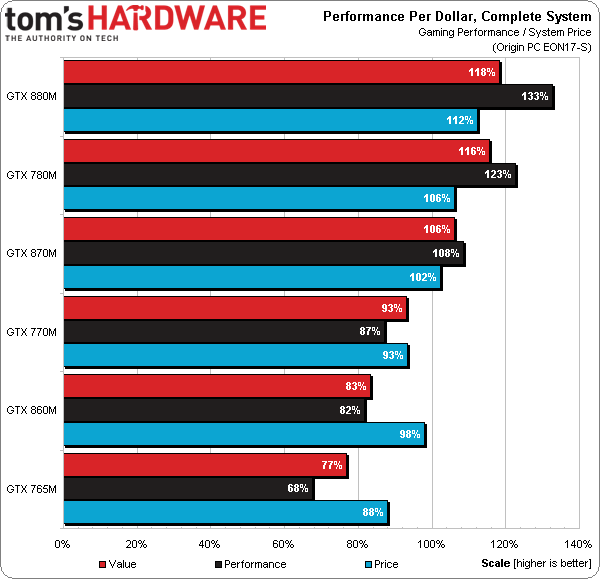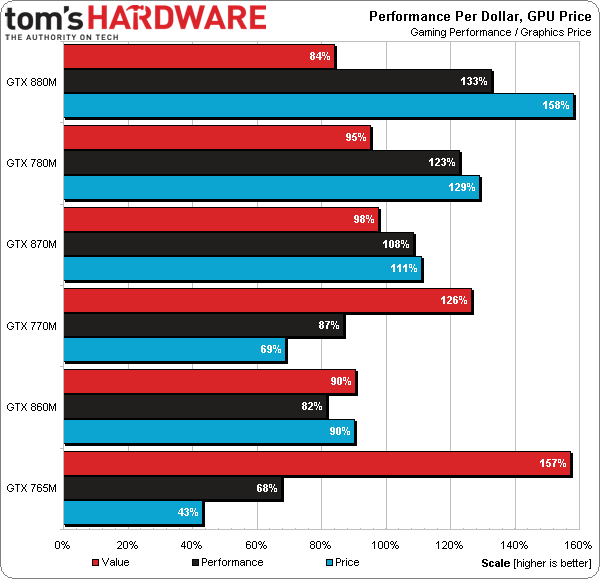GeForce GTX 880M, 870M, And 860M: Mobile GPUs, Tested
Nvidia is in the process of rolling out its GeForce GTX 800M-series graphics modules. Despite the new name, we're still looking at GK104-based GPUs. One thing is for sure, though: the processor is running faster than ever. We benchmark three models.
Is The GeForce GTX 800M-Series A Better Buy?
Focusing on Nvidia's newest GeForce GTX 800M-series graphics modules and Origin PC's mobile platform for today’s performance analysis simplifies the value comparison for us, since we only need to look one place for our pricing. Granted, the old parts were discontinued as soon as the 800Ms launched, so I did have to use February pricing in my calculations.
That also meant subtracting $78 from the configured price of the refreshed machine, since the old CPU, which Origin PC custom-installed for us, was $78 cheaper. Still, that's a marginal subtraction on a system that costs as much as ~$3000 with high-end graphics.
You do pay more for Nvidia's faster GeForce GTX 800M-series graphics modules. Regardless, the new GPUs offer enough of a performance boost to offset their premium as part of a complete system. Not only does the latest and greatest win out on performance, but also value.
A little adding and subtracting from quoted prices for various Eon17-S configurations suggests that Origin PC charges about $900 for the GeForce GTX 880M, around $600 for the 870M, and roughly $500 for the GTX 860M, as part of the package deal. That makes the 860M roughly twice as pricey as the GeForce GTX 765M. Then again, Nvidia's GK104 is a more expensive graphics processor than GK106.
Some folks will suggest that only the cost of the component under test can be used to calculate value, even when that piece of hardware affects the performance of an entire system. I tend to disagree, but went ahead and created a chart for them based on my findings, too.
This chart makes certain assumptions based on Origin PC's prices. More problematic, its results suggest that the rest of the notebook is free. The first diagram is more realistic, conveying that the biggest generational improvement happens going from GeForce GTX 770M to 870M. And that's probably the GPU I'd choose if I were spending my own money. It's adequate through our benchmark suite at the most demanding settings.
Of course, if you need even higher frame rates for 3D Vision or more taxing details in games like Metro: Last Light, you could always spend the few hundred extra dollars on the GeForce GTX 880M. That is, unless you'd like to wait for AMD's response.
Get Tom's Hardware's best news and in-depth reviews, straight to your inbox.
Current page: Is The GeForce GTX 800M-Series A Better Buy?
Prev Page Average Performance And Efficiency-
CaptainTom Eh these generations are all the same cards. Show us a 980M with full maxwell. Then we'll talk...Reply -
Puiucs we need them to finish working on 20nm fast. TSMC just can't do it anymore. global foundries has 14nm only on paper too....Reply -
guvnaguy I'm actually fairly impressed. Their website says a max of 6 hours battery on "UMA" mode. Would you be able to test this, Tom?Reply
Previously I wouldn't consider getting a gaming laptop due to their short battery life, even when not gaming. But if a laptop with this kind of hardware can manage 5 - 6 hours, I'd consider it... -
ubercake Page one gives the impression you might include desktop cards so we could get a frame of reference with regard to desktop v laptop GPU performance. Then I looked immediately at the BF4 page and found no desktop GPUs in the performance charts?Reply -
Ninjawithagun Highly disappointed overall by the 800M series performance. I can feel assured that my GTX780Ms in my Alienware 18 will serve me well for at least another year. So, whatever happened to multi-core GPUs?? The concept works well for desktop CPUs, yet we have not seen it in desktop or mobile GPUs as of yet? ATI's Hawaii GPU comes close in certain aspects regarding behavior like a multi-core GPU by handing off processes to other chips within the die. One step closer to a next-gen GPU, yet still so far...Reply -
jrharbort A shame this didn't include the Maxwell-based 860M. It performs much more in line with what we'd expect from a true next-gen mobile chip (I'm currently using said chip, and still exercising its capabilities). I can say it's roughly 30% faster than the previous gen 765M, and benchmarks by others have shown it to be twice as fast as the GTX 660M while staying at a max of 50W TDP. I've yet to do any real benchmarking myself, so if anyone cares to see any, leave me some suggestions of what to use (preferably free software).Reply -
hannibal Is there any way of knowing if you get kepler 860 or maxwell 860 when you buy a laptop?Reply
I hate these kind of naming tricks... Even 860a and 860b or anything that gives out what you will get.
-
jrharbort ReplyIs there any way of knowing if you get kepler 860 or maxwell 860 when you buy a laptop?
It is difficult to know unless you get more specific information from the manufacturer before purchase (or find benchmarks of the computer model you're looking at beforehand). The MSi GE60 Apache Pro was the first notebook to feature the Maxwell-based 860M.
I hate these kind of naming tricks... Even 860a and 860b or anything that gives out what you will get. -
dstarr3 ReplySo, whatever happened to multi-core GPUs?? The concept works well for desktop CPUs, yet we have not seen it in desktop or mobile GPUs as of yet?
GPUs have been multi-core for ages now. Well beyond desktop cores, even. The GTX880M in particular is a 1,536-core GPU. Similar numbers have been around for a long time.
http://www.geforce.com/hardware/notebook-gpus/geforce-gtx-880m/specifications


